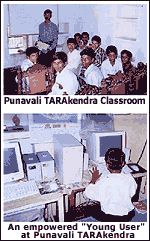Rural ICT Strategies
Our partner, Tarahaat.com (www.tarahaat.com), promoted by Delhi-based Development Alternatives, provides online services to rural communities in north India. It is both, a horizontal
as well as a vertical portal (hence a Mother portal, or ‘Mortal’) and has a unique interactive and graphics-intensive interface system, which allows even semi-literate and neo-literate users enhanced access to products and services.
TARAhaat.com has been experimenting with their revolutionary concept in TARAkendras at MP and UP since 2000.

For TARAhaat to become a successful and rapidly growing venture, each partner responsible for information or product flows must make a profit. The value chain throughout the business model has therefore been carefully designed to result in the highest possible revenue stream for each distinct activity and actor. Business plans for each player in the TARAhaat network show that, provided the range of services made available is properly chosen, significant profits can be generated at each step in the information chain.
TARAhaat combines their mother portal, TARAhaat.com with a franchised network of village cybercafes and delivery systems to provide a full range of services its clients. The subsidiary units include:
§
TARAdhaba: Provides the villager connectivity and access to a new world.
§
TARAbazaar: Provides access to products and services needed by rural households, farmers, and industries.
§
TARAvan: Delivers goods ordered.
§
TARAdak: Connects the rural families to the daughter married far off and to the son posted on the front.
§
TARAguru: A decentralized university which provides mentoring and consultancy to village-based mini-enterprises.
§
TARAreporter: TARAscouts collect relevant information for the portal.
§
TARAvendor: Runs the store that will cater to products available at Tarabazaar.
§
TARAcard: Enables the villager to order goods and services on credit.
Payment for the different types of transaction made possible by TARAhaat will be largely by cash (which research over the past 20 years shows to be more easily- though somewhat seasonally - available in rural and peri-urban areas than is commonly supposed). However, the TARAcard, which provides a highly prized photo ID to each villager, will in time become a local credit card, particularly in dealings with the TARAdhaba and TARAvan. As the TARAhaat network expands, the TARAcard can become a more widely used method of payment for goods, services and financial transactions, potentially evolving into a SmartCard with medical and other records resident on it.
Revenues to TARAhaat will come from payments received for services, commissions on sales, fees for advertising and entertainment, royalties and other sources of earnings. All these will be structured to maximise the incentives for each participant in the TARAhaat network: the user, the TARAdhaba, the TARAvan, the TARAscout, the TARAguru and TARAhaat.com and its shareholders. Overseas franchises and consultancies in other developing countries will provide revenues in the future.
The economics of the TARAdhaba franchise are critical to the success of the network. The main costs of running a TARAdhaba are: loan servicing, staffing, utilities and royalties to TARAhaat. Preliminary business plans show that the break-even for a TARAdhaba with two terminals is around Rs. 600 ($15) per day, or Rs. 20,000 ($450) per month. The revenues to cover this must come from several streams. The owner will charge each user for the time spent at the terminal. (In the cybercafes found in cities all over India, the current charges range from Rs. 50 to 100 -- $ 1 to 2 -- per hour).
In addition, the TARAdhaba will charge a brokerage fee for certain kinds of transactions and information delivery. Other revenue sources include displaying ads from local businesses and professionals, downloading educational materials and accessing official information, application forms, etc.
TARAhaat's revenues come from the wide range of services it provides to its end-clients, the villagers; its franchises in the form of royalties and service fees; its advertisers; its vendors and its other business partners, all of whom will benefit by the growing market for the their products and services made possible by TARAhaat. Alliance partners, who collaborate and contribute to building up TARAhaat in the initial stages of its development, will continue to have a special relationship, including the use of the network for their own marketing purposes on special terms.
|